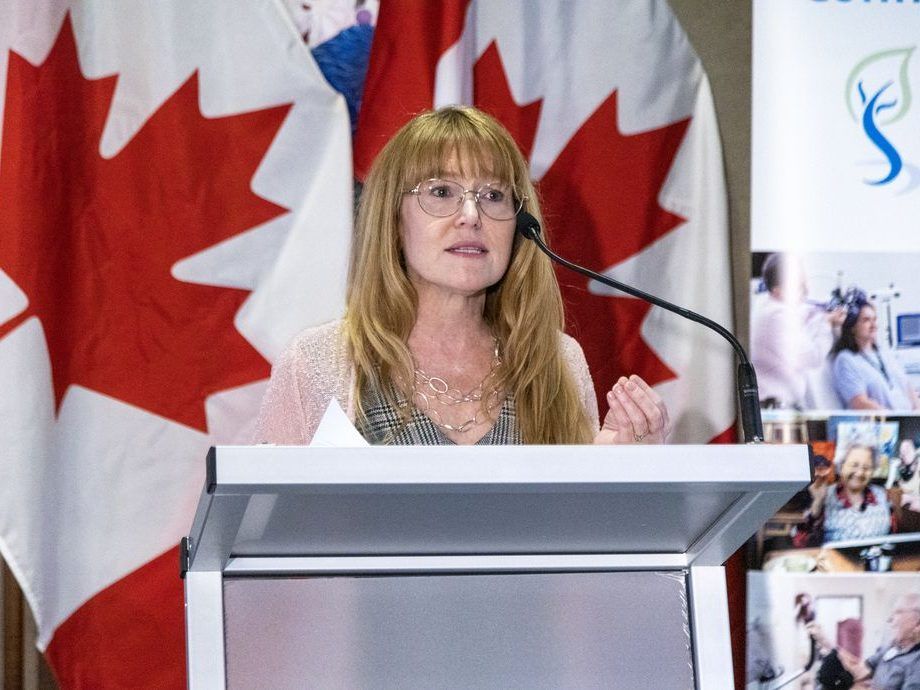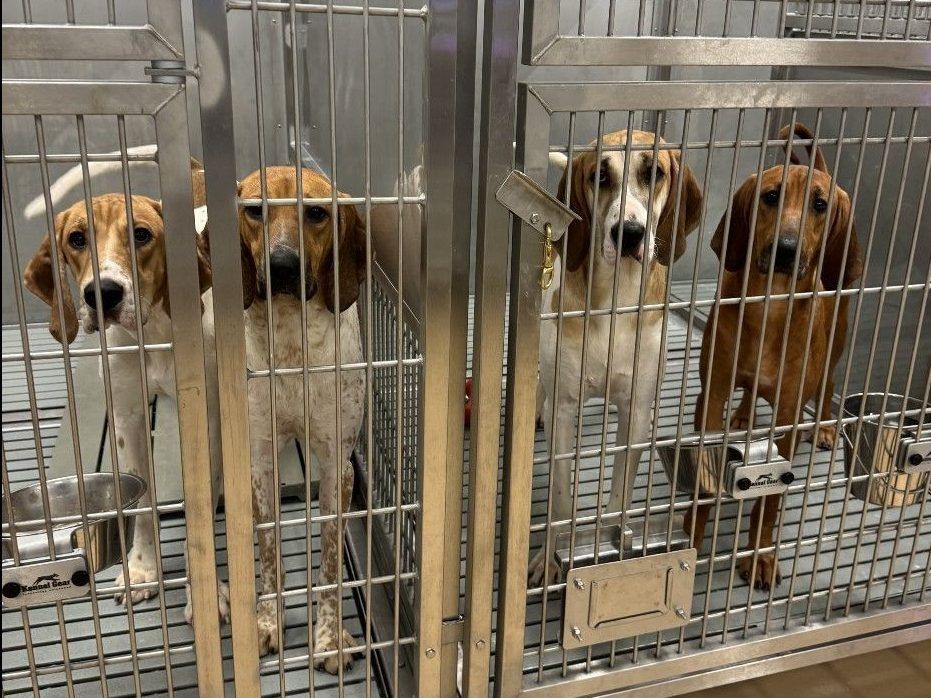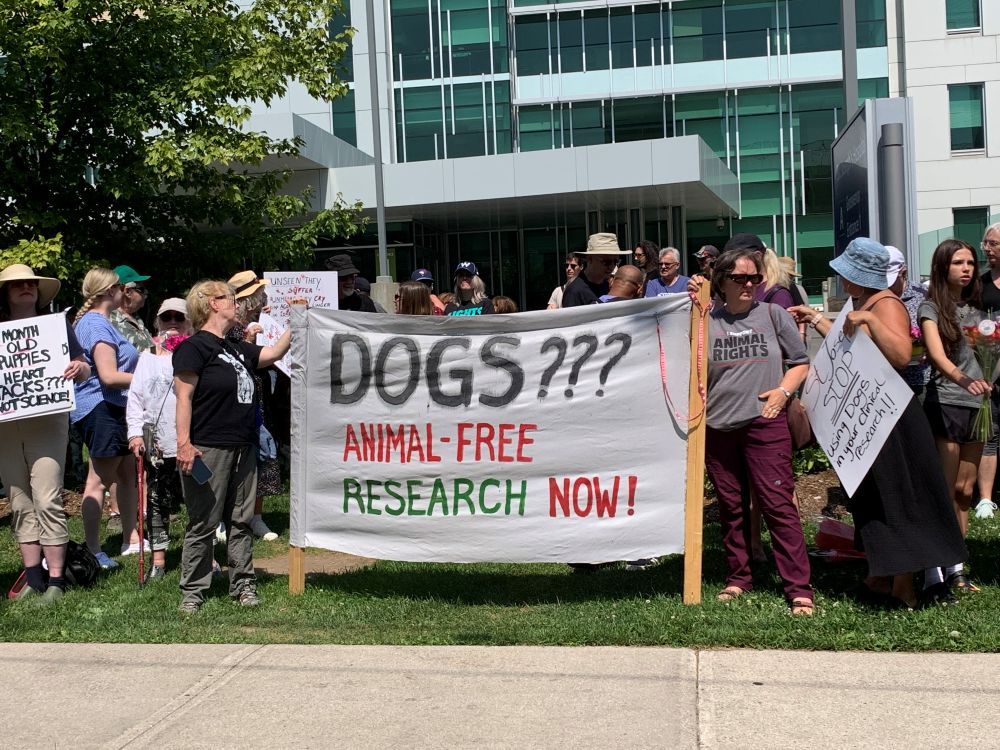
The head of a research lab that induced heart attacks in dogs as part of human heart research is no longer with St. Joseph’s Hospital where she oversaw the animal experimentation.
A week after an IJB investigation into the clandestine dog testing program at St. Joseph’s triggered widespread public and political outrage, the hospital, which shut down the animal testing program Monday on orders from the premier of Ontario, announced Dr. Lisa Porter is gone.
The email address for the former vice-president of research and scientific director of the Lawson Research Institute at St. Joseph’s Health Care London bounced back on Thursday. And a profile about her on the hospital’s website has been taken down.
A statement Thursday from Roy Butler, chief executive of St. Joseph’s Health Care, says the hospital is launching an independent third-party review of its research involving animals after Premier Doug Ford called it “inhumane” and “terrible.”
Following the “cessation of research involving dogs, we are working on a transition plan to minimize the impact on our researchers and their work, which has resulted in major strides in cardiac care and treatment,” reads Butler’s statement.
The hospital has routinely euthanized dogs involved in its research. Butler’s statement says it is now seeking “opportunities for rehoming them.” In a previous statement to the IJB, the hospital said it has not rehomed a single dog used in its research in the past five years.
“We understand there are personal opinions about the merits of research involving animals, but it is important to be clear about the scientific, transparent, ethical and regulated approach taken to this work and our adherence to these strict standards,” Butler wrote.

On Aug. 7, just hours after the IJB investigation was published, Porter gathered staff for a meeting amid already swirling public backlash.
The IJB investigation detailed a secretive, decades-old animal testing program that regularly received caged puppies covered by blankets from U.S. breeders for experiments that forced the animals into heart failure lasting as long as three hours. Staff were told not to speak about the dogs outside the lab and to ensure empty dog food bags are not visible in the trash.
Angry phone calls and emails were flooding into the hospital in response to the story. Animal rights advocates and dog lovers were planning a public vigil in front of the hospital that Saturday that would draw more than 100 people.
But inside the Lawson Research Institute, staff were resolute, vigorously defending their work and strategizing a crisis management plan.
“We know that the work that happens here is done ethically,” Porter said to her staff, according to an audio recording of the meeting obtained by the IJB. “The animals used in this research, we all know, they are heroes, born and bred to serve in research…These dogs wouldn’t be alive if it weren’t for this work. They were born to do this work.”
Interview requests to Porter and St. Joseph’s seeking comment on the meeting did not receive a response. And the hospital did not respond to specific questions about Porter’s comments.
Speaking with her staff, Porter took firm aim at two anonymous whistleblowers who provided IJB reporters with eyewitness accounts, internal study protocols, images and video for review and analysis.
“(Study protocols) are not meant for the public because the public doesn’t understand the science,” Porter told staff.
The guidelines of the Canadian Council on Animal Care (CCAC), which oversees animal testing in Canada, say “a summary of the primary aims and proposed use of animals must be provided in a language understandable to a layperson. This should include a description of procedures designed to assure that animal suffering will be prevented or at least minimized.”
Lawson’s own dog testing study protocols reviewed by the IJB have sections titled Lay Summary which asks researchers to describe the study “in terms that a lay reader can understand – using language appropriate to an intelligent but non-specialist audience – and using a minimum of technical jargon.”
Porter told staff that, if identified, the whistleblowers will be fired.
“It’s a complete breach of confidentiality. We’ve already checked with legal,” she told the room.
Whistleblowers told reporters they were ordered to hide the existence of the dogs by cranking loud music to drown out barking sounds from patients and other staff.
Porter acknowledged to her team that the practice of playing loud music to hide the dogs in the lab may not be optimal.
“The loud music is actually just causing attention. So I wonder if we hold off on the music.”
She also expressed some regrets about the secrecy surrounding the dog research program that dates back decades.
“Should we have been more transparent with animal research from the beginning? I think so. Admittedly, I think if we could reverse ourselves back a few years, that would be a good thing for us to do. But I also understand the (communications) side of things with patients, etc., they have additional concerns that a research institute at a university would not.”
In a statement Thursday, the hospital said “all research involving animals requires security and biosecurity measures to protect the safety of the animals in our care, staff and the integrity of the research. Security measures are standard in research facilities and are part of our accreditation process and protocols.”
Porter said the IJB investigation inspired a recognition that the facility needs to communicate better with both the public and hospital colleagues about the work they are doing.
“Those communications haven’t happened and we need the clinicians and the staff to be behind the good work that happens here,” she said.
“When I saw the video I felt sorry for the whistleblowers…The fact that they were part of the work happening in animal care who didn’t know how important this research is. They felt compelled to do this. To me, they have done a massive disservice to all of you, they’ve done a massive disservice to the research but they felt they had no choice. Obviously, we have to really resonate on that and think what we need to do better.”

According to images and videos obtained by the IJB, the dogs entered the hospital through back receiving doors as young as 10 months old. They were all eventually killed, their hearts removed for further study.
Their bodies often ended up in garbage bags placed in a bin for removal, according to the whistleblower and images from inside the lab.
In response to concerns from one staff member at the meeting who suggested the disposal protocol could be seen as disrespectful, Porter said the process could be modified.
“Like other places, it’s possible for us to do a ceremony to recognize the contribution of the animals.”
Porter advised staff to direct any public complaints to the hospital’s communication team and to be careful about their written correspondence on the issue for fear of reporters obtaining the material.
“(Reporters) can do an (freedom of information) search for information…They’ll be looking through emails, etc….Just so everybody knows, when you’re emailing out…we really do need to be mindful of our communications.”
The research was publicly funded and approved by scientific reviewers.
A hospital statement following publication of the IJB investigation said “values of respect, excellence and compassion are foundational to our ethical care and treatment of animals in research. We are also regulated and guided by rigorous policies and procedures for high-quality animal care.”
But there remains vigorous debate among scientists over whether the research requires the sacrifice of dogs.
“This is an exemplary case study of everything that’s wrong with the modern culture of science,” said Charu Chandrasekera, founder of the Canadian Centre for Alternatives to Animal Methods and an international expert in animal-free science.
“Scientists are not gods. We don’t have carte blanche to do whatever we want. It has to be scientifically and ethically rigorous. None of this is scientifically rigorous and there is zero accountability.”
Chandrasekera, who reviewed the statements made by Porter during the staff meeting, took issue with several of her comments.
“Calling dogs ‘heroes’ who were ‘born to do this work’ is a moral inversion. It’s not destiny, it’s design,” Chandrasekera said. “Saying the public ‘doesn’t understand the science’ is a deeply paternalistic dodge – it assumes ignorance rather than admitting the public might understand perfectly well and reject it. If your work can’t withstand public scrutiny, the problem isn’t the public.”
The dog research at St. Joseph’s has been well financed by public and philanthropic sources.
Using public records, the IJB has identified more than $3 million in total funding received by the lab’s researchers from government funding and foundations including the Heart and Stroke Foundation.
Asked for confirmation on the total amount of public and donated funds received for dog research over the past five years, St. Joseph’s officials did not respond.
The research has been happening for much longer than that. The IJB has found studies on dog use by the same researchers dating back to the 1980s.
Michelle Pitt recalls dogs from St. Joseph’s Hospital being test subjects in heart failure experiments as early as 2002.
As part of her former job as a research assistant at London Health Sciences Centre (LHSC), she says she witnessed 13 dogs arrive from St. Joseph’s 23 years ago for use in heart imaging experimentation involving induced heart attacks. The dogs were temporarily moved to LHSC for a few weeks, she says.
Like the whistleblowers, the former employee says the dogs were caged with no beds for 23 hours a day before being killed at the end of the research.
Shortly after, Pitt says she left her job after 14 years due to what she calls the trauma from witnessing the animal research.
“It was horrible. It was destroying my soul…I tried to do the best I could for them, but they weren’t under my care…. It will haunt me for the rest of my life. I’m just shocked that they’re still doing this. It should stop.”
St. Joseph’s officials did not respond to requests for comment on Pitt’s allegations.
An archived copy of Porter’s profile that previously appeared on the hospital’s website says she was raised in Sault Ste. Marie. She is a distinguished professor in biomedical sciences at the University of Windsor and the founding director of We-Spark Health Institute that specializes in research, education and training, and community engagement.
“She is convinced that St. Joseph’s is an ideal place where health research and improved patient care intersect,” the article reads.
The Investigative Journalism Bureau (IJB) at the University of Toronto’s Dalla Lana School of Public Health is a collaborative investigative newsroom supported by Postmedia that partners with academics, researchers and journalists while training the next generation of investigative reporters.